中国传统服饰色彩(英文版)
- 格式:doc
- 大小:7.13 MB
- 文档页数:49
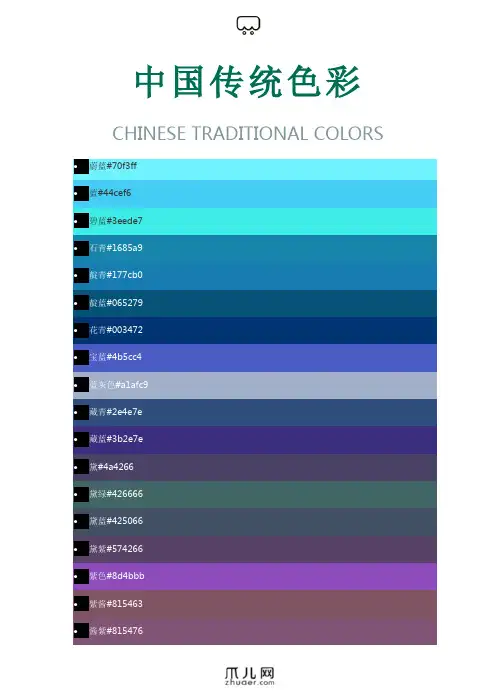
中国传统色彩CHINESE TRADITIONAL COLORS •蔚蓝#70f3ff•蓝#44cef6•碧蓝#3eede7•石青#1685a9•靛青#177cb0•靛蓝#065279•花青#003472•宝蓝#4b5cc4•蓝灰色#a1afc9•藏青#2e4e7e•藏蓝#3b2e7e•黛#4a4266•黛绿#426666•黛蓝#425066•黛紫#574266•紫色#8d4bbb•紫酱#815463•酱紫#815476•紫檀#4c221b •绀青#003371 •紫棠#56004f •青莲#801dae •群青#4c8dae •雪青#b0a4e3 •丁香色#cca4e3 •藕色#edd1d8 •藕荷色#e4c6d0 •朱砂#ff461f •火红#ff2d51 •朱膘#f36838 •妃色#ed5736 •洋红#ff4777 •品红#f00056 •粉红#ffb3a7 •桃红#f47983 •海棠红#db5a6b •樱桃色#c93756 •酡颜#f9906f •银红#f05654•石榴红#f20c00 •绛紫#8c4356 •绯红#c83c23 •胭脂#9d2933 •朱红#ff4c00 •丹#ff4e20 •彤#f35336 •酡红#dc3023 •炎#ff3300 •茜色#cb3a56 •绾#a98175 •檀#b36d61 •嫣红#ef7a82 •洋红#ff0097 •枣红#c32136 •殷红#be002f •赫赤#c91f37 •银朱#bf242a •赤#c3272b •胭脂#9d2933 •栗色#60281e•柳黄#c9dd22 •嫩绿#bddd22 •柳绿#afdd22 •葱黄#a3d900 •葱绿#9ed900 •豆绿#9ed048 •豆青#96ce54 •油绿#00bc12 •葱倩#0eb83a •葱青#0eb83a •青葱#0aa344 •石绿#16a951 •松柏绿#21a675 •松花绿#057748 •绿沈#0c8918 •绿色#00e500 •草绿#40de5a •青翠#00e079 •青色#00e09e •翡翠色#3de1ad•缥#7fecad •艾绿#a4e2c6 •石青#7bcfa6 •碧色#1bd1a5 •青碧#48c0a3 •铜绿#549688 •竹青#789262 •墨灰#758a99 •墨色#50616d •鸦青#424c50 •黯#41555d •樱草色#eaff56 •鹅黄#fff143 •鸭黄#faff72 •杏黄#ffa631 •橙黄#ffa400 •橙色#fa8c35 •杏红#ff8c31 •橘黄#ff8936 •橘红#ff7500•姜黄#ffc773 •雌黄#ffc64b •赤金#f2be45 •缃色#f0c239 •雄黄#e9bb1d •秋香色#d9b611 •金色#eacd76 •牙色#eedeb0 •枯黄#d3b17d •黄栌#e29c45 •乌金#a78e44 •昏黄#c89b40 •棕黄#ae7000 •琥珀#ca6924 •棕色#b25d25 •茶色#b35c44 •棕红#9b4400 •赭#9c5333 •驼色#a88462 •秋色#896c39 •棕绿#827100•棕黑#7c4b00 •赭色#955539 •赭石#845a33 •精白#ffffff•银白#e9e7ef •铅白#f0f0f4 •霜色#e9f1f6 •雪白#f0fcff •莹白#e3f9fd •月白#d6ecf0 •象牙白#fffbf0 •缟#f2ecde •鱼肚白#fcefe8 •白粉#fff2df •荼白#f3f9f1 •鸭卵青#e0eee8 •素#e0f0e9 •青白#c0ebd7 •蟹壳青#bbcdc5 •花白#c2ccd0 •老银#bacac6•苍色#75878a •水色#88ada6 •黝#6b6882 •乌色#725e82 •玄青#3d3b4f •乌黑#392f41 •黎#75664d •黧#5d513c •黝黑#665757 •缁色#493131 •煤黑#312520 •漆黑#161823 •黑色#000000。
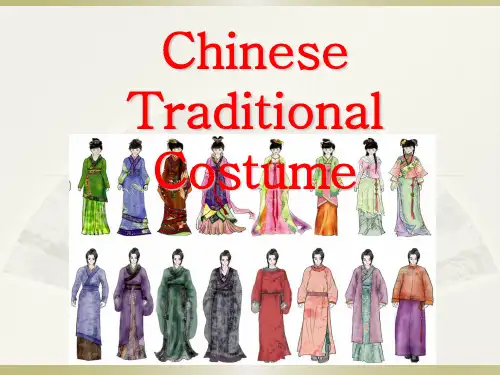
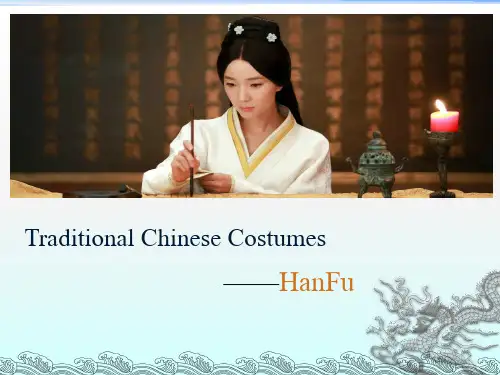
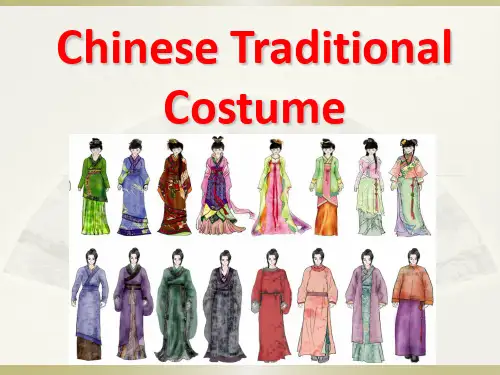
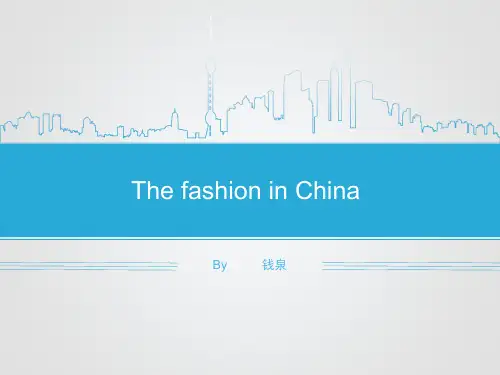
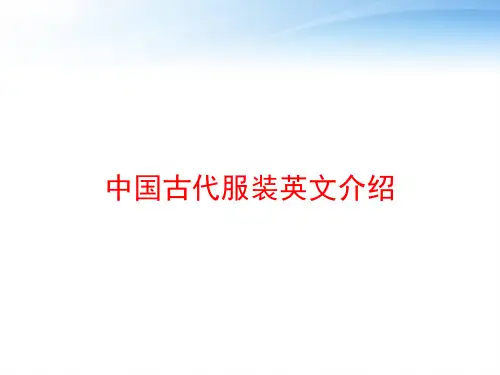
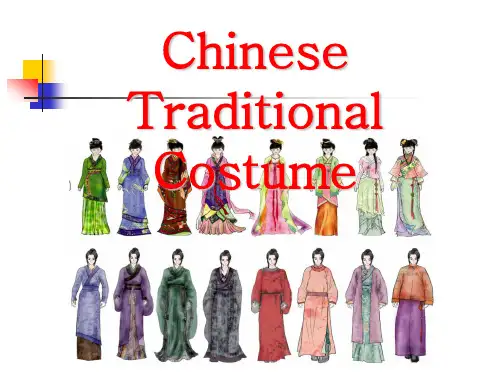
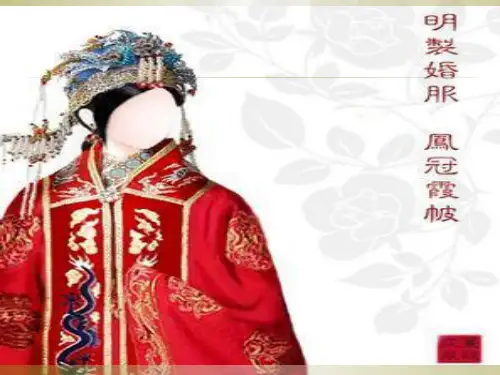
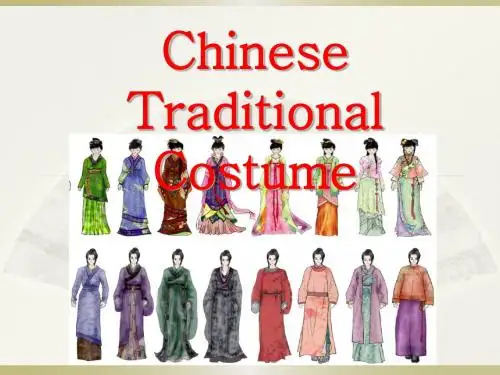
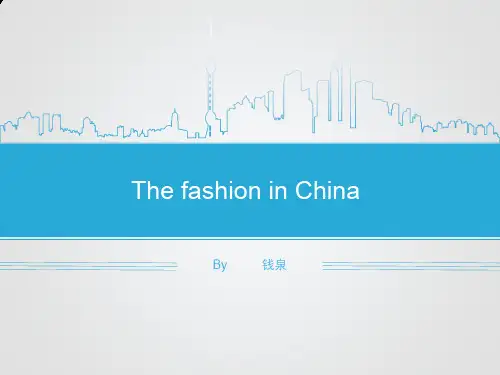
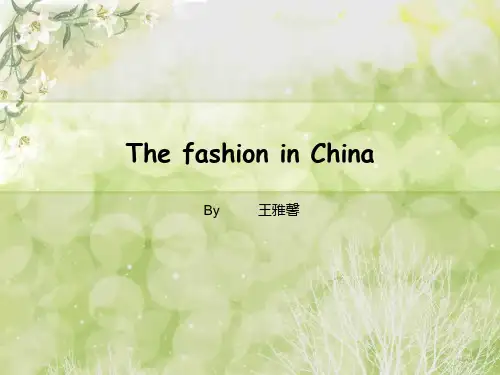
中国传统元素服装英语分享When it comes to traditional Chinese clothing, there are a few key elements that are often incorporated into the design. These elements have a rich history and are still influential in modern fashion. Let's explore some of these traditional elements and their significance.First and foremost, traditional Chinese clothing often features intricate embroidery. This is a highly skilledcraft that involves stitching intricate designs onto fabric, often using silk threads. Embroidery can depict a widerange of motifs, including flowers, birds, and othernatural elements, as well as symbols of luck and prosperity. This embellishment adds a touch of elegance and cultural richness to the garment.Another important element of traditional Chineseclothing is the use of vibrant colors. Red, in particular,is a popular choice as it symbolizes good fortune and joyin Chinese culture. Other colors such as gold, blue, and green are also commonly seen in traditional clothing, each with its own symbolic meaning. These bold and bright colorsmake traditional Chinese clothing visually stunning andfull of cultural significance.In addition to embroidery and vibrant colors,traditional Chinese clothing often features distinctive silhouettes and designs. For example, the cheongsam, also known as the qipao, is a form-fitting dress with a high collar and intricate button details. This style of dress has been popularized in both traditional and modern fashion and is recognized for its graceful and elegant appearance.Furthermore, traditional Chinese clothing often incorporates symbolic motifs and patterns. For instance, the dragon and phoenix are frequently used to represent power and prosperity, while the peony flower symbolizes beauty and grace. These motifs are often woven or printed onto fabric, adding layers of meaning and cultural significance to the garment.When it comes to accessories, traditional Chinese clothing is often paired with ornate hairpieces, jewelry, and footwear. Hairpins adorned with pearls and precious stones, jade bracelets, and embroidered shoes are just a few examples of the accessories that complement traditionalChinese attire. These accessories serve to enhance the overall aesthetic and showcase the attention to detail that is characteristic of traditional Chinese fashion.In summary, traditional Chinese clothing ischaracterized by intricate embroidery, vibrant colors, distinctive silhouettes, and symbolic motifs. Theseelements come together to create garments that are not only visually stunning but also rich in cultural significance. Whether worn for special occasions or incorporated into modern fashion, traditional Chinese clothing continues tobe a source of inspiration and admiration.说到中国传统服装,有一些关键元素经常被融入到设计中。
小学生英语作文中秋节的传统服饰(中英文翻译)中秋节是中国传统的重要节日之一。
在这个节日里,人们会穿上传统的服饰来庆祝。
下面是小学生英语作文中秋节的传统服饰,以及相应的中英文翻译。
《中秋节的传统服饰》Traditional Costumes for Mid-Autumn Festival中秋节是中国的传统佳节之一。
人们在这一天会举行各种庆祝活动,其中之一就是穿上传统的中秋节服饰。
这些服饰不仅美丽,还富有文化内涵。
一、女性传统服饰1. 旗袍(qípáo)旗袍是中秋节女性最常穿的传统服饰之一。
它是由长袍演变而来的,以其简洁的设计和优雅的曲线而闻名。
旗袍通常是以丝绸或棉布制成的,经过精致的缝制和刺绣。
2. 对襟衫(duìjīnshān)对襟衫也是中秋节女性常穿的传统服饰之一。
对襟衫是一件有领子和纽扣的上衣,通常配以长裤或长裙。
对襟衫的颜色多为红色或粉色,寓意喜庆和美丽。
二、男性传统服饰1. 唐装(tángzhuāng)唐装是中秋节男性常穿的传统服饰之一。
它是受古代唐朝服饰影响而设计的,以其简约大方而闻名。
唐装通常由长袍、长裤和对襟上衣组成,颜色多为深蓝或黑色。
2. 长袍(chángpáo)长袍也是中秋节男性常穿的传统服饰之一。
长袍是中国古代的传统服饰,通常是由丝绸制成的。
长袍的设计非常简单,但给人一种庄重和典雅的感觉。
三、中英文翻译1. 旗袍(Qípáo)- Qipao2. 对襟衫(Duìjīnshān)- Chinese Button Shirt3. 唐装(Tángzhuāng)- Tang Suit4. 长袍(Chángpáo)- Changpao这些传统服饰在中秋节期间被广泛穿着,不仅增添了节日的喜庆氛围,还展示了中国的优秀传统文化。
通过穿上这些服饰,人们可以更好地感受到传统与现代的结合,传承与创新的融合。
阅读材料:中国传统服饰英文简介Chinese Traditional Costumes of Past Dynasties 中国历代传统服饰China, known as a" land of dresses", has a long history in the development of its clothing culture. Dresses in different periods reflect, to a certain extent, the situation of the politics, economy, military affairs, religions, and the civil customs of the specific historical stages. In the primitive society, people led a simple life in caves and generally worn nothing. In the Neolithic Age, the ancestors of the Chinese people were able to make tools. They invented bone needles and sewed primitive cloths. About 5,000 years ago, during the Yangshao Cultural Period, people lived a stable life and agriculture and textiles came into being. They raised silkworms and began to weave silk clothing which made people's clothing more perfect. After human kind entered the class society, clothing became the symbol of people's social statuses. During the Western Zhou Dynasty (1066-771B.C.), China virtually had a complete clothing system. From the Zhou Dynasty to the elimination of the feudal society in China, emperors, empresses, imperial concubines, princes, princesses, officials, and common people were attired in different ways.Chinese clothing in the past dynasties can be roughly divided into the following categories: clothing of the remote times; that of the Shang and Zhou Dynasties; that of the Qin and Han Dynasties; that of the Wei, Jin, and Northern and Southern Dynasties; that of the Sui, Tang ,and the Five Dynasties; that of the Song Dynasty; that of the Liao, Jin, and Yuan Dynasties; that of the Ming Dynasty; that of the Qing Dynasty; and that of modern times.Costumes of Minority Groups of China 中国少数民族服饰China is a country consisting of 56 ethnic nationalities, and each of them has its own clothing style with distinct ethnic characteristics, due to the influence of different culture, traditions, and geographical feature. On the other hand, they influenced andlearned from one another in the way they dresses themselves as people of various ethnic lived together or migrate.As a result, the dresses of various ethic groups, like their culture, share something in common while they have their own ethnic, regional, and traditional features as well as traces of merge and transformation, forming a brilliant feature, colorful clothing culture of the Chinese. Roughly speaking, the loose gown and long robe worn by the people of the minority tribes in northern China are straightforward and the long skirt and pants worn by the people in southern China are made of fine workmanship. Due to the impact of the complicated geography and climate, the clothing of the minority nationalities in southern China is richer in variety and more colorful than that of the minority groups in the north. Dresses are the important symbols of the ethnic nationality identification and the blood lineage of China's minority groups. People usually are attired in special way on such occasions as festivals, wedding, religious, and funeral ceremonies, and other important activities. The change of clothing manifests an ethnic group's economic life, religious belief, world outlook, ideology, aesthetic consciousness, customs, and its course of development.Chinese Qipao Dress (Cheongsam) 旗袍中山装The Qipao dress dates back to the Ming and Qing Dynasties. Perfectly fitting the beautiful figure of Asia females, it is regarded as quintessence of China, reflecting the Chinese culture and arts. While the Qipao makes people's life more colorful with its national characteristics and strong happy colors and fashion designs, it possesses a lasting value itself.。